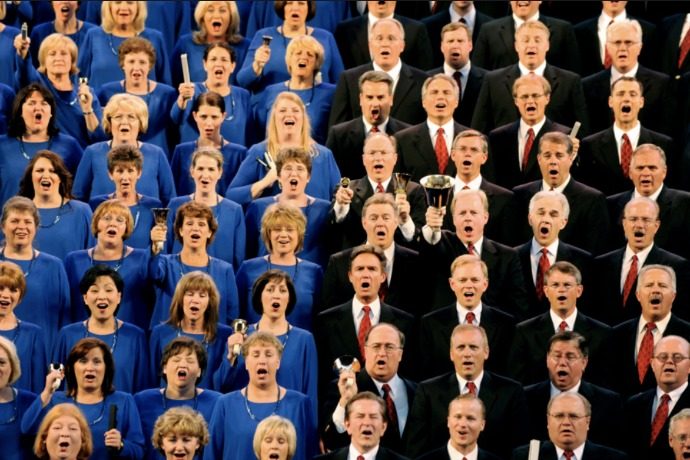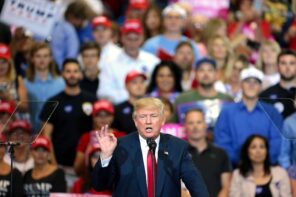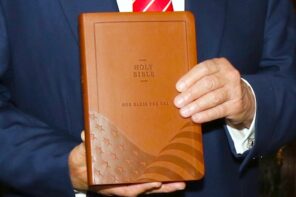After much controversy (including a singer quitting in protest) the Church of Jesus Christ of Latter-day Saints’ famed Mormon Tabernacle Choir will perform at Donald Trump’s presidential inauguration today. And its performance couldn’t be more prominently placed, “sandwiched,” as a headline in Deseret News announced this week, between Pence’s oath and those of the new president.
But there were moments in the last year when it seemed the Mormon community might take a stand against Trump’s presidency. When the candidate proposed a ban on Muslim immigration, the LDS Newsroom released a statement reaffirming its support for a plural society. And a month before the election, several prominent Mormon politicians revoked their endorsement of his candidacy, the Church-owned newspaper requested that he step down from the ticket, early polls showed Utah to be a toss-up state, and some observers wondered if the Church could lead the opposition to Trump and his supporters within the Republican Party.
Coupled with the rise of Evan McMullin, a conservative candidate from Utah who happens to be Mormon, things looked ripe for political turnover within the state of Utah in general and the Mormon tradition in particular—even if the rift would only be temporary until the Republican party nominated someone more in line with its values.
Cracks in this opposition appeared shortly before the election. Julie B. Beck, who had served as president of the Mormon faith’s women’s organization, participated in a pro-Trump rally in October. This endorsement appeared to give permission for many Mormons to support the Republican nominee, and Trump’s lead increased throughout the state. On election day, Donald Trump won Utah easily, as his vote total nearly doubled those received by McMullin and Hillary Clinton.
The extent of Mormon support for Trump is debatable. Pew found that, nationwide, 61 percent of Mormons voted for Trump, which was higher than any other category outside of white evangelicals; the Utah College Exit Poll, however, with a much higher number of Mormon participants, put the number closer to 45 percent. Both figures are well below previous Mormon voting percentages for the Republican candidates, but they indicate that at least half of Latter-day Saints were willing to stomach Trump’s apparent moral deficiencies.
This turn of events has historical precedent. Though the LDS Church’s political affiliation was malleable for the first century of its existence, since World War II, Mormonism has been closely aligned with the Republican right. Several prominent conservative leaders, along with shifting demographic allegiances, placed white Mormons in the Mountain West in the same company with white evangelicals. At many of these moments of cultural strengthening, the Mormon Tabernacle Choir was there to serve as a musical coronation. It was only fitting, then, that at Ronald Reagan’s inauguration—the event seen as the culmination of the religious right’s coalition—the new president dubbed the Mormon Tabernacle Choir “America’s Choir.” The moment seemed to signify the LDS church’s move from the periphery to the mainstream.
But that trajectory toward assimilation was tested in recent years. Mitt Romney’s presidential run strained the extent of Mormonism’s acceptance within American culture. At the same time, the LDS Church’s opposition to same-sex marriage, epitomized in their energetic backing of California’s Proposition 8, drew immense ire. The brief but pervasive “Mormon Moment” simultaneously put the faith tradition on a prominent stage while also demonstrating its continued odd fit. Perhaps the Church’s integration had not been as successful as they hoped.
This moment of cultural dissonance could have led to a divorce within the religious right, or at least a more malleable alliance. The LDS insistence on family values, immigration and (actual) religious freedom could have stood in contrast to the evangelical leaders, like Jerry Falwell Jr., who served as messengers of Trump’s gospel. But when faced with political alienation, Church leaders clung to the tradition of the last half-century by building capital through conservative causes. Their decision to participate in Trump’s inauguration, after so many other groups had declined, epitomizes the Church’s priority of fitting into its surrounding culture, even at the expense of contrasting and competing values.
If the Mormon Tabernacle Choir’s participation in Ronald Reagan’s inauguration was the coronation of the Church’s assimilation with the religious right, its involvement with Donald Trump’s represents the extent to which it will defend that position. It embodies both Mormonism’s integration within America’s political power structure as well as its inability to conceive of a world outside of it.





